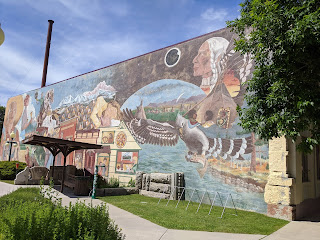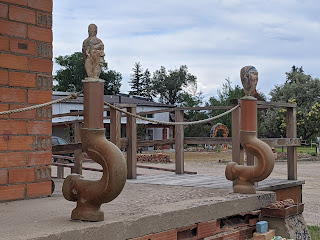Earlier that July day, Steven and I had arrived in Montana's capital city of Helena from Kalispell. The city, also known as Queen City of the Rockies, owed its existence to "The Georgians," four disheartened Southern prospectors who stumbled down a gulch they nicknamed Last Chance Gulch and found gold on what became Helena's main street, called naturally enough Last Chance Gulch!

The crooked path of Last Chance Gulch followed original mining claims and memorialized Helena's chaotic beginnings as a gold camp in 1864. Within a year of the discovery of gold, a boomtown flourished with homes and businesses in tents and log cabins.
After a fire burned most of downtown, the center was replaced over the next few years by brick and granite buildings. Helena survived after the gold ran out because pioneer entrepreneurs had made it a financial center. The arrival of the Northern Pacific Railway in 1883 and Helena's election as the state capital in 1894 confirmed the town's survival.
Extra! Extra! Read All About It! The sculpture was a tribute to those who sold their papers on these street corners, bringing the latest news to the people of Helena.

The Bullwhacker:

Who could resist walking down the city's main drag, now set aside for pedestrians, with such an unusual name, especially knowing the historic district was listed in the National Register of Historic Places? Certainly not us! I have become an admirer of architecture the more we travel both domestically and internationally. That was why I found the granite buildings so attractive.
The Atlas Building was especially unique!
Commerce that started during Helena's Gold Rush days continued to flourish with traders supplied by freight wagons from Fort Benton.
Performance Square was located on the Gulch.
After we'd toured the statehouse earlier, Steven and I noticed the Last Chance Tour Train that was about to depart from the History Museum. If it hadn't been for Covid-19 and our wish to socially distance, it would have been a real hoot taking the train through town. We didn't mind missing it too much because we saw it by the Cathedral of St. Helena, on the Gulch, and several other places as we wandered through town!
Being a new fan of murals, I was very glad to see these ones! According to the sign on the mural written by the Helena Board of Trade in 1889, "Helena is peculiarly cosmopolitan, and that very fact is the reason for the tremendous energy and activity shown here."
The 1979 Women's Commemorative Mural honored the unacknowledged contribution of the women in Montana history.
We then looked for reminders of Helena's early days in the architecture of the buildings that lined Reeder's Alley located a few blocks away from Last Chance Gulch. Pennsylvania brick mason Louis Reeder came to the city in 1867 to practice his trade.
Before entering the Alley, though, we got sidetracked looking at the city's oldest residences that were also listed in the National Register of Historic Places. The Caretaker's Cabin:
The 1864 Pioneer Cabin was likely the oldest structure in Helena and one of the oldest cabins in the state. It was a typical miner's cabin and the only unadulterated remnant of the great gold rush. When four hungry miners took a 'last chance' and found color, i.e. gold, in their pans, gold seekers moved to stake their claims. One of them built this cabin. Within the first four years, $19 million dollars of gold was discovered near here.
Unfortunately because of Covid-19, we couldn't enter the restored and furnished cabin to view items from the cabin's early residents.
The Yee Wau Cabin was typical of the tiny dwellings that once lined Last Chance Gulch and was one of the last built near the end of the gold rush in 1870. From 1876-1886, the Yee Wau brothers who were longtime local dealers in Chinese merchandise and groceries owned the property. Though there was discrimination and anti-Chinese legislation, Chinese immigrants accounted for ten percent of Montana's territorial population. These pioneers made significant contributions, especially in laying the tracks of the Northern Pacific across Montana in the 1880s. Chinese dwellings, businesses, and large gardens spread for five blocks below Reeders Alley.
When Reeder invested in real estate between 1873 and 1884, among his properties were these apartments he constructed on a steep hillside. They first housed single miners working claims and later pensioners. The alley comprised Helena's most complete remaining block of the territorial period.
What a shame that we were the only people wandering up the interesting Reeders Alley on that beautiful early July day as it felt like a ghost town. It just cried out for people popping in and out of the shops.
In 1938, the Last Chance Restoration Association began one of the West's first preservation efforts by purchasing the Pioneer and Caretaker's cabins. Three Helena women rescued the alley from demolition in 1961. It was gratifying to know that the historic neighborhood had survived fires, the 1893 silver panic, the 1935 earthquakes, the 1970s Urban Renewal, and the test of time!
We strolled back to the center of town, passing once again the mural that had caught our attention earlier. Although I was quite taken by Helena's many charms, the quietness and almost emptiness would have gotten to me over the long haul, I suspect. I think I need a town with a little more traffic than this!
As it was getting late in the afternoon, the Queen City Jazz Band was entertaining locals and visitors alike back on Last Chance Gulch.
Some more stately buildings charmed us as we walked back to our car.
As we drove toward the city's historic carousel, we thought for a moment we'd time-traveled to the Middle East and come across a minaret and mosque! However, the unusual building was just the Civic Center.
Being new fans of historic carousels since discovering several on this trip through much of the Pacific Northwest, I was excited to see what the Great Northern Carousel looked like. It featured 37 hand-carved Montana animals. How magical it would be to bring our two new granddaughters, Max and Clara, on a tour of carousels when they're older!
A good piece outside of town was the Archie Bray Foundation for the Ceramic Arts which was founded on the site of the Western Clay Manufacturing Company in 1951 by its namesake, a brickmaker, philanthropist, and arts patron. The core of the foundation was its artist residency program.
The Bray as it was commonly known was also listed in the National Register of Historic Places.
We read online that after a difficult assessment of the impacts of the Covid-19 pandemic, the foundation had made the decision to cancel all on-campus programs and activities until further notice. Though closures even included public access to the grounds, we saw no one who questioned our presence as we strolled through the grounds.

The Bray was a fascinating, whimsical sculpture park and a fun ending to our exploration of Montana's capital city. I was so glad we'd added a stop in Helena as I was quite taken with its stunning statehouse, exquisite cathedral, quirky Last Chance Gulch, the historic Reeders Alley, devotion to the city's heritage, intriguing architecture, and The Bray. Though a small capital city, Helena had lots to offer and impress tourists in my opinion. People looking for a smaller city to live in would be hard pressed to find a better place to out down roots although I might wonder what Montana winters were like!
Next post: We continued our exploration of our country's national parks with a drive to Yellowstone and its Norris Geyser Basin.
Posted on November 18th, 2020, from our home in the foothills west of Denver. With the numbers of Covid-19 cases and deaths reaching such alarming rates, please practice the 3 W's: wear a mask, wash your hands, and watch your distance to be safe.

























































No comments:
Post a Comment